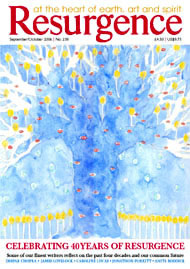IN INNUMERABLE NOTEBOOKS made from his student days onwards, the painter Ben Hartley (1933–96) recorded both nature and his humble rustic surroundings in succinct, hand-written notes and beautifully spontaneous drawings. His script was simple, yet his unpretentious lines form the most original poetry. This intimate, moving book reproduces just seven of his notebooks, covering 1964–5, when Hartley lived in the Devon village of Ermington, with holidays spent travelling around the country.
By all accounts, he was a quiet, shy, rather physically frail man, yet indomitable as an artist (trained at the Royal College of Art, his own exuberantly innocent voice was nourished by enjoyment of painters such as Bonnard and Matisse), as a superb poet, and as a well-read, intuitive thinker, a natural mystic. The reader (and spectator) of Pigs must eat on Sundays feels, however, that he or she uncovers Hartley’s interior riches, so abundant in natural humour and pristine clarity.
The year 1964 begins harshly. On 4th February, Hartley wrote “Gardening beginning” – below a drawing of a Wellington-booted man (as he noted the next day) “still attacking his hedge | (Mr S.) | the slaughterer – still slashing | cold, dry, grey & songless.” By the 22nd of the same month, earth and hope are stirring: “Blue-skied day | skimming along | skipping, thrilling | wind-blown breath-in-deeply day | Been a boy again: | trespassed … | & scrambled earthy banks | & almost had to cross a | stream upon a fallen tree.” The diary’s next page shows emblems of “thrilling” new life: a watering can (pencil-drawn with childlike economy) above rows of solitary blooms: narcissi and tulips, some vividly crayoned-in.
On 29th February, the day begins with the sight of “Armadas of milk bottles | at the Creamery – Daws”, followed by the poignant question: “& why go to London? | why – The world is so green …” Then follows a sighting of the “green world”: “A horse chestnut | in full dress”. Hartley resisted the horse chestnut’s allure, and caught a train to the Smoke, writing: “On Paddington Station: – I spy | folk ‘grown-in-gardens’ | country feet & the herbaceous-border-look | of the Unlondoners.”
On 24th May, five simple words convey with touching wit how this by now thirty-one-year-old man feels about himself: “choir boys run, | – I amble.” Below are two expansive yet refined pencil drawings: one of a watchful cat luxuriating in the long grass, the other of a chubby feline lolling on its back, paws delightedly in the air.
A few days later, Hartley records: “A golden evening | & the light is from heaven.” Christian calendar days are often noted; on 12th July: “Trinity VII | Thistletide | & ham & egg for dinner | Little wren – a farthing of a bird” (its minuscule roundness evoked in a sweetly naive pencil sketch below). His entry for 3rd March 1965 does not separate the day’s spiritual atmosphere and its actual weather: “Ash Wednesday – wildest Ash Wednesday | Wind & rain & severe all day.” This particular page is made the more striking by the previous entry: a fearsome close-up of a ruddy bull’s head (like his description elsewhere of “One big, bored bull”). For him, down-to-earth nature and mystical reality are wondrously one.
Hartley celebrated rural life by noting it simply, sensuously and directly: “The silence of a summerday | but not unhummed by insects”, a “rusty alarmclock | of a pheasant”, “Poor bullocks’ faces | devilled with the flies”; “The ping of milk into a pail”. His rustic characters are (like himself) “Unlondoners”: a man, for example, pictured as “Braces red | & vest of string | & ‘drat the flies’”; another seen by a ramshackle farm building, exclaiming: “Gat sum rat | poison in there.”
Intuitively sophisticated, Hartley didn’t romanticise unmechanised country life but enjoyed its vigorous singularity, as this delicious haiku-like observation shows: “not a blackbird | – but a pram’s squeaking | song in the road”. His disciplined yet unforced attunement to nature is reminiscent of the vision of John Clare, the great 18th-century English peasant poet, and Hartley’s own contemporary, the East Anglian painter (and poetic note-maker) Mary Newcomb. Hartley’s solitary, lovingly discerning character made him a fiercely keen observer, and he described and portrayed what he saw each day with revelatory freshness.
Philip Vann is author of Face to Face: British Self-Portraits in the Twentieth Century.







